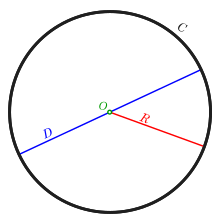
| Geometry |
|---|
 |
| Geometers |
In geometry, a diameter of a circle is any straight line segment that passes through the centre of the circle and whose endpoints lie on the circle. It can also be defined as the longest chord of the circle. Both definitions are also valid for the diameter of a sphere.
In more modern usage, the length of a diameter is also called the diameter. In this sense one speaks of the diameter rather than a diameter (which refers to the line segment itself), because all diameters of a circle or sphere have the same length, this being twice the radius
For a convex shape in the plane, the diameter is defined to be the largest distance that can be formed between two opposite parallel lines tangent to its boundary, and the width is often defined to be the smallest such distance. Both quantities can be calculated efficiently using rotating calipers.[1] For a curve of constant width such as the Reuleaux triangle, the width and diameter are the same because all such pairs of parallel tangent lines have the same distance.
For an ellipse, the standard terminology is different. A diameter of an ellipse is any chord passing through the centre of the ellipse.[2] For example, conjugate diameters have the property that a tangent line to the ellipse at the endpoint of one diameter is parallel to the conjugate diameter. The longest diameter is called the major axis.
The word "diameter" is derived from Ancient Greek: διάμετρος (diametros), "diameter of a circle", from διά (dia), "across, through" and μέτρον (metron), "measure".[3] It is often abbreviated or
- ^ Toussaint, Godfried T. (1983). "Solving geometric problems with the rotating calipers" (PDF). Proc. MELECON '83. Mediterranean Electrotechnical Conference, 24–26 May 1983, Athens. IEEE. CiteSeerX 10.1.1.155.5671. (pdf pages in reversed order)
- ^ Bogomolny, Alexander. "Conjugate Diameters in Ellipse". www.cut-the-knot.org.
- ^ "Diameter—Origin and meaning of diameter by Online Etymology Dictionary". www.etymonline.com.




